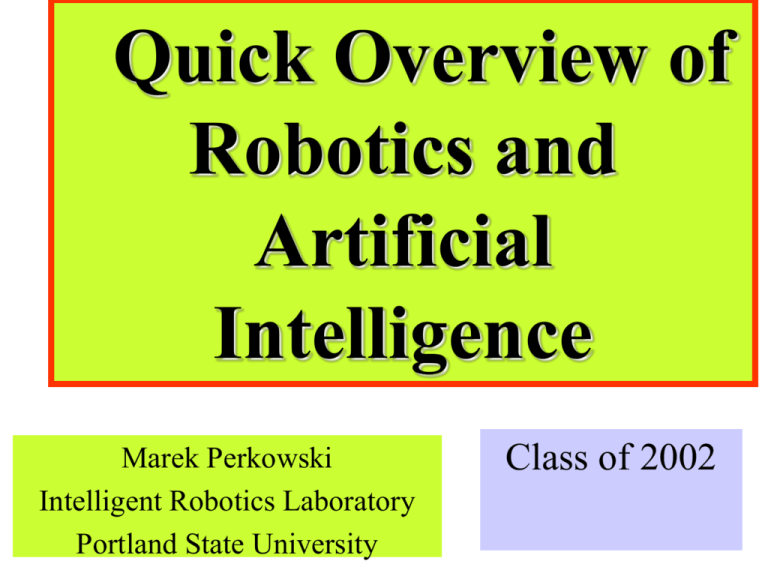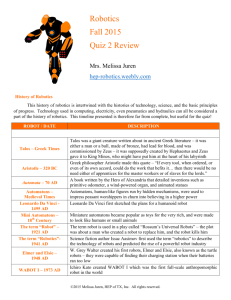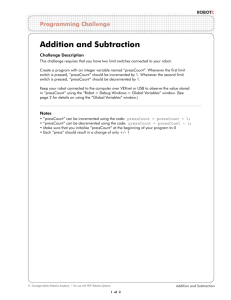Introduction to Robotics Class - Electrical & Computer Engineering
advertisement

Quick Overview of Robotics and Artificial Intelligence Marek Perkowski Intelligent Robotics Laboratory Portland State University Class of 2002 Intelligent Robotics = Robotics + Artificial Intelligence • ECE 478/479: – Course website www.ece.pdx.edu/~mperkows – Instructor: Marek Perkowski Office: FAB (Fourth Avenue Building), room 160-05 Extension: 725-5411 Email: mperkows@ee.pdx.edu Hours: TR 3:30-4:30 (or by appointment) Recitations: Fridays 6-9pm, room CECS 54 Intelligent Robotics = Robotics + Artificial Intelligence • Textbooks: Luger and Stubbefield, Artificial Intelligence, Structures and Strategies for Complex Problem Solving, Addison Wesley, newest edition Fred G. Martin, Robotic Explorations. A Hands-On Introduction to Engineering. Prentice-Hall, 2001. Additional Textbooks: Russell & Norvig, Artificial Intelligence. A Modern Approach, Prentice Hall Wilensky, Common LISPcraft Another very good LISP textbook: Winston & Horn, LISP (Addison-Wesley) Joseph L. Jones, Bruce A. Seiger and Anita Flynn, Mobile Robots. Inspiration to Implementation. Second Edition, A.K. Peters Other good textbooks and sources The Physical World •The physical world is very demanding, it is: •inaccessible - sensors are imperfect, only stimuli that are near the agent can be perceived. •nondeterministic - a robot needs to deal with uncertainty •nonepisodic - effects of an action change over time •dynamic - robot needs to decide when to think and when to act immediately •continuous - states and actions are drawn from a continuum of physical configurations and motions Robotics Research area in which AI agents are equipped with sensors to perceive the world and effectors to change it Schedule & Grades • Grading scheme: 50% Project 25% Homeworks and programming assignments 25% Exams • Programming assignments: 4-5 assignments in LISP Be sure to check the course web site for policy on turning in assignments late • Exams: Exam 1 (10% of grade): LISP programming (around end of 1st week in February - it will be announced) - open book Exam 2 (15% of grade): Mid-term - theory (open book) Computer Accounts • To apply for account, for a registered PSU student: cat@ee.pdx.edu • Lab rules & policies: Posted on the wall in the Intelligent Robotics Lab Course Details Three coursework requirements • Written assignments mathematical / algorithmic material (25%) • Lab Projects robot or simulator programming (50%) • Presentation on a robotic system/algorithm (25%) also organized by lab group deliverables: slides and the talk (demo) late in the semester Hands-on Introduction to Robotics • We start from basic problems in robotics • Various types of robots, applications • Lego System: – Mindstorms – Dacta Control Lab – Dacta Robo Lab • Other kits: – OWI – Robix – Lynxmotion • Other inexpensive robots: – Halloween Items – Home Depot Robots Contents of this quarter • • • • • • • Artificial Intelligence Programming for Intelligent Robotics Robot Kinematics Motors and Control - more next quarter Sensors - more next quarter Image Processing and Robot Vision Machine Learning and Pattern Recognition – more next quarter • Mobile Robots - walking robots Background Dramatic changes in technology in recent years enable robotics education My past robots • 1972 - light following, light avoiding – basic instinct, adaptive control, finite state machine • 1979 - industrial robot, first in Poland – voice control • 1982 - inexpensive robotic arm – no learning, software only • 1986 - 1988 - converted toys, image processing • 1989 - 1992 - PSUBOT – image processing, voice recognition, path planning, obstacle avoidance • 1990 - 1995 - robotic class at PSU, micro-mouse, no robot in a lab • Robotics was very expensive and painful, you had to do most of work from scratch! What happened recently?? • Robot Arm: – 1985 = $ 2,300, – 1999 = $ 35 • Camera with a grabber: – 1985 = $ 2,400, – 1999 = $ 26 • Computer capable of doing real-time image processing: – 1985 = > $ 10,000 – 1999 = $ 600 • Computer on mobile robot – 1985 - very simple controller – 1999 - powerful complete laptop • Voice Recognition – 1985 - single words – 1999 - continuous spoken language What are the definitions of a Robot? Definition of a Robot • According to The Robot Institute of America (1979) : "A reprogrammable, multifunctional manipulator designed to move materials, parts, tools, or specialized devices through various programmed motions for the performance of a variety of tasks." • According to the Webster dictionary: "An automatic device that performs functions normally ascribed to humans or a machine in the form of a human (Webster, 1993)." Robot Definitions (cont) •Russell and Norvig: an active, artificial agent whose environment is the physical world. •Robots differ from Softbots whose environment consists of computer systems, databases and networks. What is a robot? - more definitions • Fictional definition: any system with sensors, computer and effectors. Robots must have a minimum of 4 degrees of freedom. A degree of freedom is the number of independent movements an object can perform in a three dimensional space One more definition What is robotics? One more definition Robot a physical system that autonomously senses the environment and acts in it. What is the origin of word ROBOT? The word robot originated from the Czech word Robota Czech word "robota” means "forced labor.”. • Three laws of robot’s by Science fiction author Isaac Asimov. • The word "Robot" comes from the play "R.U.R." (Rossum's Universal Robots) RUR • R.U.R. was written in 1920 by the Czech writer Karel Capek (pronounced "chop'ek"). • Premiered in Prague early in 1921 • Performed in New York in 1922, and published in English translation in 1923. The play was a great success when it opened in the U.S. • Robot derives from the Czeck word for "worker" • The brilliant scientist Rossum manufactures a line of robots designed to save mankind from work. • The plot turns sinister when robots are used in a war to kill humans. • After the robots are given emotions they no longer tolerate humans and eventually wipe them – out...neat thought eh? R.U.R. • This is a robot from the play "R.U.R." (image from the Robot Museum web site). • Karel Capek died just after the German invasion of Czechoslovakia in 1938, before the Gestapo (the German secret police) could get to him. The role of Isaac Asimov • The word "robotics" also comes from science fiction - it first appeared in the short story "Runaround" (1942) by Isaac Asimov. • This story was later included in Asimov's famous book "I, Robot." • The robot stories of Isaac Asimov also introduced the idea of a "positronic brain" (used by the character "Data" in Star Trek) and the “three laws of robotics” • Later, he added the "zeroth" law. Three Laws of Robotics: Highest order law • * Law Zero: A robot may not injure humanity, or, though inaction, allow humanity to come to harm. • * Law One: A robot may not injure a human being, or, through inaction, allow a human being to come to harm, unless this would violate a higher order law. • * Law Two: A robot must obey orders given it by human beings, except where such orders would conflict with a higher order law. • * Law Three: A robot must protect its own existence as long as such protection does not conflict with a higher order law. Robotics is a Synthetic field • Mechanical Eng. • CS & AI • Biology • Electrical Eng. • Vision, HCI • Neuroscience • Control • Software Dev. • Cognitive Science Robotics Robotics is a Synthetic field • Mechanical Eng. • CS & AI • Biology • Electrical Eng. • Vision, HCI • Neuroscience • Control • Software Dev. • Cognitive Science Robotics • Architecture • Sensing and Motion • Mapping • Cooperative Robotics • Entertainment • Planning / Modeling • Visual Control • Robot Learning Low-level control • motors • purely reactive control • behavioral control Sensing and Modeling • sensors • kinematics • workspace modeling Spatial reasoning • decomposing space • path planning with • and w/o full knowledge Handling uncertainty • building maps • localization • sensor fusion & filtering Vision • tracking • visual servoing Typical Projects Kamikaze Robot The Buggy Butler “Wallflower” “The Extinguisher” The Manipulator E “Pioneer” Big Brother Vision • tracking • visual servoing Problems for you to think about • 1. Think about your project for this class • 2. Define a robot in your own words. Compare your definition. • 3. How to program Asimov’s Laws? • 4. Can we build a group of robots to perform Capek’s play in Portland Cyber Theatre? Why not, why yes? Think what robots they should be. • 5. Visit the Intelligent Robotics Lab and familiarize yourself with our robots Sources • • • • • Padhraic Smyth Dodd, Harvey Mudd College Kiriakos Kutulakos, University of Rochester Rojas FUB MI Behnke • Brian Glassman, Mechanical Engineering at Florida Institute of Technology • John Gallagher, SUNY Institute of Technology





